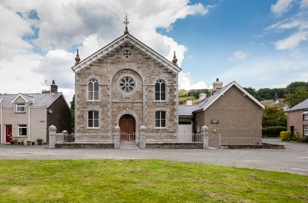A new life for Welsh chapels?
 Judith Alfrey, head of conservation and policy at Cadw, the Welsh Government’s historic environment service, explains how the physical survival of the Welsh chapel is as important for today’s society and future generations as it was for communities in the past. But, sometimes, for different reasons…
Judith Alfrey, head of conservation and policy at Cadw, the Welsh Government’s historic environment service, explains how the physical survival of the Welsh chapel is as important for today’s society and future generations as it was for communities in the past. But, sometimes, for different reasons…
In Wales, you will never be very far from a chapel: they stud our towns and are often the focal points of remote upland settlements. These instantly recognisable nonconformist places of worship are a distinctive and familiar feature of the landscape.
From a small handful in the early eighteenth century, they increased to several thousand in number by the early twentieth century — reportedly built at a rate of one new chapel every eight days in the first half of the nineteenth century. Chapels were at the heart of community life for thousands of people and remain an important part of our cultural heritage.
However, there has been a slow decline in chapel congregations over the last one-hundred years. Many chapels have closed or face a struggle to stay open as they deal with the challenge of maintaining buildings that were built for much larger congregations. Our challenge now is to work out how best to sustain this heritage by giving it renewed value and meaning in a very different world.
There have been some imaginative responses to this problem, founded on local determination and commitment, with some external support. Across Wales, chapels have been given a new lease of life. Not only have these buildings been saved for the future — they have stimulated the regeneration of local communities.
Burnett’s Hill Chapel in Martletwy, Pembrokeshire, for example, is an early Calvinistic Methodist chapel dating from 1812. It has become a much-loved concert venue popular for folk music.
The size of the local community reduced greatly following the end of coalmining in Pembrokeshire in the mid-nineteenth century. By the mid-twentieth century, the congregation was tiny and, by 1984, the chapel had fallen into disrepair and was closed.
It lay empty until 2001 when it was acquired by Pembrokeshire Coast National Park Authority and restored with help from the Heritage Lottery Fund. An active friends group has since taken over the freehold and running of the chapel and services are held there once more.
Capel Carmel in Pennal, Gwynedd, is another example of a chapel that has been sympathetically adapted for use by the local community without losing its original purpose as a place of worship. By 2006 it had just 24 members, despite its seating capacity for 400 in 1871. The chapel itself had fallen into disrepair but was given a new lease of life with funding from the Big Lottery and a conservation grant from Cadw.
The chapel vestry was extended, a new link to the original chapel was built and the original pews removed to create a more flexible space for use at the heart of its community. A wide range of local groups now use Canolfan Pennal, including the post office for a few hours a week.
Another chapel, in Bargoed, has won several awards for its innovative transformation into a library and community facility.
Built in 1906–07, Hanbury Road Chapel became underused and dilapidated and faced an uncertain future.
The project to transform its fortunes was delivered in partnership with Caerphilly County Borough Council, United Welsh Housing Association (who purchased the building) and the existing congregation. It was supported by the Welsh Government through its Heads of the Valleys initiative (as part of the regeneration of the town), and also received funding from Cadw and CyMAL.
The new library is housed in the main body of the chapel — which still retains its open space and gallery; there is a place for worship in the former Sunday school. A bold new extension at the rear provides an accessible entrance and a community café as well as additional library and office space. The library opened in October 2011 and welcomed more than 17,000 visitors in its first month.
Of course, not all chapels have to change to survive. There are many that are still fulfilling their original purpose and sometimes opening their doors for visitors to see their beautifully crafted interiors.
Some of the best examples of redundant (non-Church in Wales) chapels are cared for by The Welsh Religious Buildings Trust, which encourages community participation in their use and care. But it is clear that there are also new ways in which chapels can continue to be at the centre of their local communities, sustaining a link to a heritage which is a vital part of the identity and character of Wales.
For more information about caring for chapels and securing their future, please contact Cadw (cadw.wales.gov.uk), the Welsh Religious Buildings Trust (welshreligiousbuildings.org), the National Churches Trust (nationalchurchestrust.org), Capel (capeli.org.uk) and the Heritage Lottery Fund (hlf.org.uk).















